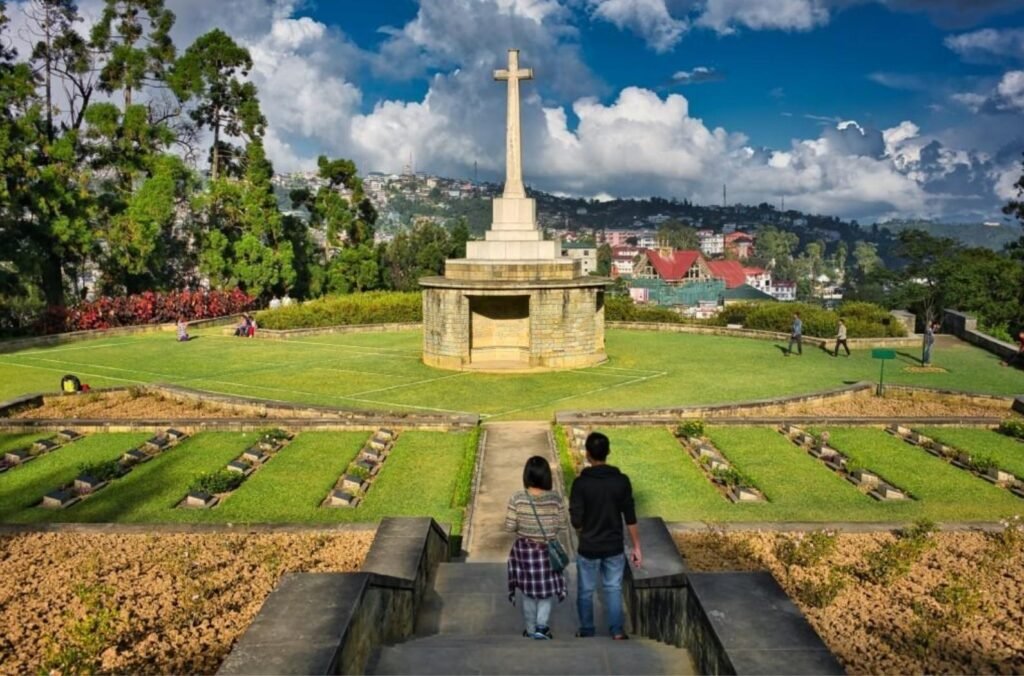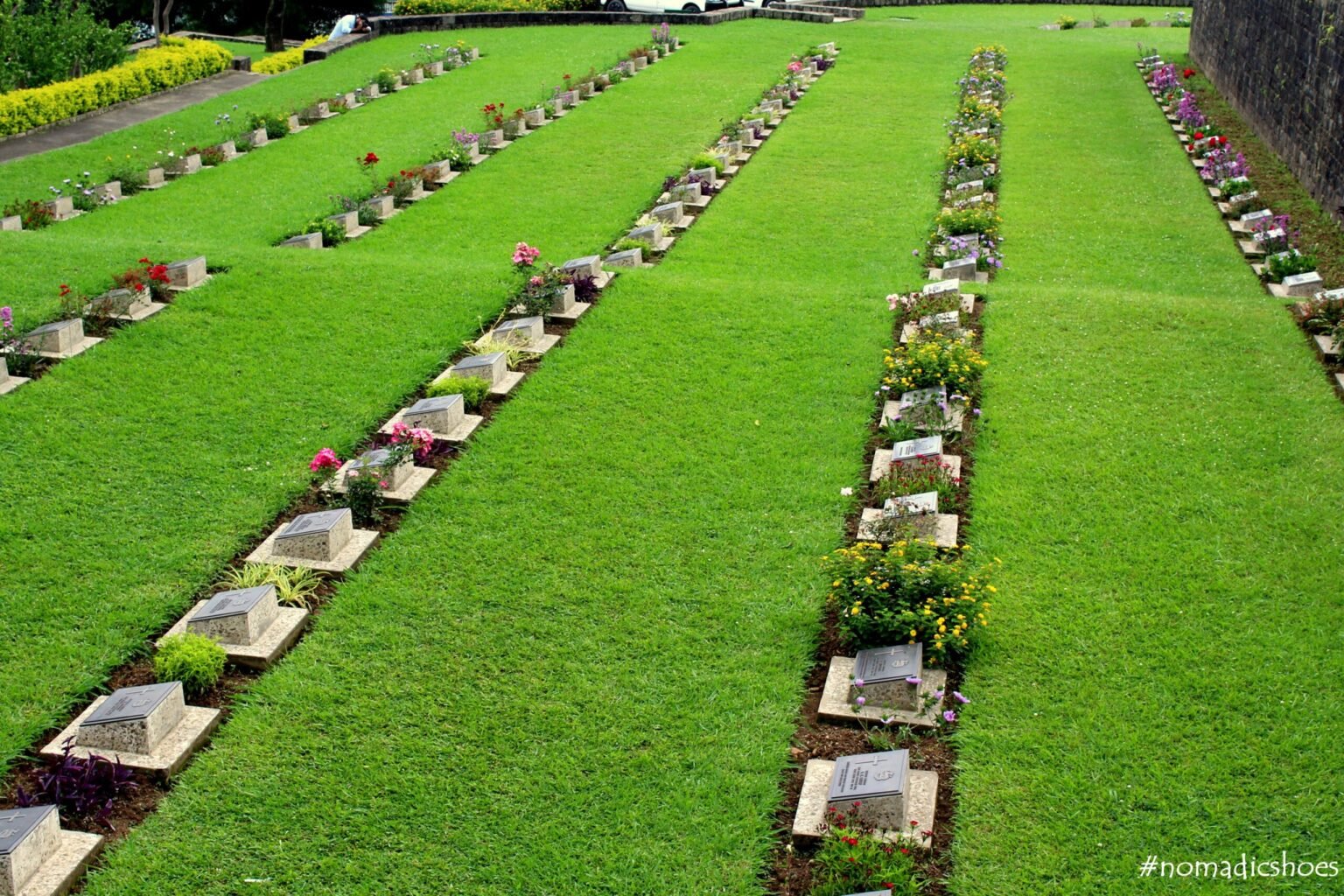Kohima War Cemetery stands as a living testament to courage, resilience, and the enduring pursuit of peace that echoes far beyond the hills of Nagaland. Nestled amidst pristine landscapes, this cemetery is more than a resting place for over 1,400 soldiers; it is a pilgrimage site, a historical archive, and a symbol of unity.
Kohima War Cemetery, located atop the scenic Garrison Hill in Kohima, Nagaland, commemorates the soldiers of the Allied Forces who died during the gruelling Battle of Kohima in World War II. The cemetery has earned respect as one of the most moving war memorials in the world, marked by its sombre epitaph: “When you go home, tell them of us and say, for your tomorrow, we gave our today”.
How to Reach Kohima War Cemetery
- By Air: Dimapur Airport is about 63 km away (approx. 2 hours by road).
- By Train: Dimapur Railway Station, 68 km away, followed by a road journey of about 2.5 hours.
- By Road: Well-connected by taxis, buses, and shared vehicles to Kohima town; final approach may include gentle trekking for panoramic access.
- Location: Centrally located in Kohima, near key city landmarks; the cemetery lies north of the Imphal-Dimapur road, on the original battleground.
Key Details:
| Aspect | Details |
|---|---|
| Location | Garrison Hill, Kohima, Nagaland, India |
| Historical Significance | Memorial to over 1,420 Commonwealth soldiers killed in the Battle of Kohima (WWII, April–June 1944) |
| Design & Features | Terraced lawns, memorial panels, Cross of Sacrifice, tennis court battlefield, panoramic city views |
| Maintained By | Commonwealth War Graves Commission (CWGC) |
| Cultural Importance | Annual memorials, Remembrance Day, Hornbill Festival nearby, site of peace and reconciliation |
| Entry Fee | Free for all visitors |
| Visiting Time | Open daily, 8:00 a.m. – 4:00 p.m. |
| Best Time to Visit | October to May (pleasant weather, avoids monsoon rains) |
| Duration of Visit | Typically 1–2 hours |
| Accessibility | Centrally located in Kohima, accessible by taxi, bus, shared vehicle; short trek from the city centre |
| Nearest Airport | Dimapur Airport, approx. 63–74 km (2–3 hours by taxi/bus) |
| Nearest Railway Station | Dimapur Railway Station, approx. 68 km (2.5 hours by road) |
| Tourist Amenities | Clean premises, guided tours during key events, basic facilities nearby |
| Nearby Attractions | Naga Heritage Village, Kohima Museum, Dzukou Valley, Catholic Church, WWII Museum |
| Travel Cost (from Dimapur) | Taxi: ₹2000–3000 (one way); Bus: ₹400–600; Shared vehicle: ₹250–350 per person |
| Accommodation Range | Hotels and guesthouses in Kohima: ₹1200–5000 per night (varies by season and class) |
| Best Months for Events | April (Battle Anniversary), December (Hornbill Festival), Remembrance Day in May |
History: Battle and Remembrance
The Battle of Kohima (April–June 1944) was the decisive turning point for the Allied campaign in India and Burma. Outnumbered Commonwealth and Indian troops valiantly held Garrison Hill against the Japanese 15th Army, in what later became known as “Britain’s Greatest Battle”. The fighting was especially fierce around the Deputy Commissioner’s tennis court, on the very soil where the cemetery now stands. The eventual Allied victory marked the beginning of the end for Japanese advances into India, altering the course of history in Southeast Asia.
Kohima War Cemetery Today
- Graves and Memorials: 1,420 Commonwealth burials; memorial panels for 917 cremated Hindu and Sikh soldiers.
- Design: Serene terraces, manicured lawns, white concrete markers, and two memorial crosses.
- Epitaph: The emotional inscription by John Maxwell Edmonds is globally recognised as a symbol of sacrifice.
- Cremation Memorial: Honours soldiers in accordance with their religious practices, reflecting respect for diversity.
Cultural and Symbolic Significance
The cemetery transcends military commemoration. It is a pillar of reconciliation, cross-cultural solidarity, and lasting peace. The diversity of those commemorated underlines shared sacrifice across races, faiths, and geographies. The Naga population’s support and involvement during the wartime siege formed a unique bond, pulling a remote region into the world’s historical spotlight.
Tourist Spot: Visitor Experience
Attractions:
- Serene panoramic views of Kohima city and the surrounding hills.
- Educational tours for students and history enthusiasts.
- Site photography, nature walks, quiet reflection.
Tourist Amenities:
- Open daily, typically 8 am–4 pm; entry is free.
- Clean, maintained grounds; guided tours available in peak seasons.
- Facilities for both domestic and international visitors.
Nearby Places of Interest
Combine your visit with these Kohima gems:
- Naga Heritage Village (Kisama): Experience indigenous Naga culture.
- Kohima Museum: Artefacts and stories from Kohima’s varied past.
- Dzukou Valley: Hiking, trekking, and nature scenes.
- Catholic Church, Kohima: Architectural beauty and peaceful ambience.
- World War II Museum: Artefacts, photographs, interactive displays (seasonal).
| Place | Distance from Cemetery | Highlights |
|---|---|---|
| Naga Heritage Village | 12 km | Naga festivals, traditional houses |
| Dzukou Valley | 25 km (trekking) | Wildflowers, scenic trekking |
| Kohima Museum | 2 km | Local history and culture |
| Catholic Church | 1.5 km | Largest cathedral in Nagaland |
| WWII Museum | Seasonal/Varies | Wartime relics and history |

Revenue and Economic Impact
While specific annual revenue figures are proprietary, the Kohima War Cemetery is a consistent contributor to local and regional tourism income. Visitor fees are waived, but the influx of Indian and international tourists, especially around memorable dates, significantly bolsters Kohima’s hospitality, travel, and handicraft sectors. The site also receives funding for preservation under the Commonwealth War Graves Commission and local government heritage programs.
Culture and Events
Every year, Kohima hosts commemorative ceremonies, most notably on Remembrance Day in May and during the famed Hornbill Festival in December. The war cemetery becomes a focal point for veterans, diplomats, military officials, and local communities to pay their respects and celebrate the message of unity and peace. Traditional Naga music and cultural events are often held nearby, blending solemn remembrance with vibrant celebration of life.
Preservation and Challenges
Preserving the sanctity of the cemetery in the face of urban expansion, heavy monsoons, and growing tourist traffic is an ongoing effort. The Commonwealth War Graves Commission, in coordination with local authorities, continually works on upkeep, digital archiving, and public education. Accessibility improvements, environmental measures, and visitor education programs ensure that the site retains its dignity for generations to come.
List of Notable Names & Memorial Features
- Memorial panels display all available names of identified and unidentified soldiers.
- The Kohima Cremation Memorial lists and honours Hindu and Sikh soldiers who were not buried but cremated per their customs.
- The cemetery’s design incorporates the historic tennis court, now immortalised with white concrete lines and bronze markers.
Recent News
As the world increasingly values sites of remembrance and reconciliation, Kohima War Cemetery’s reach has only grown. In 2025, international visitor numbers soared, with delegations from across Europe, Asia, and Africa, underscoring the cemetery’s growing role as a centre for peace education and cross-cultural dialogue.
Special interactive installations, digital history tours, and Naga cultural showcases have been added to the experience. Community-led volunteer programs support ongoing conservation and eco-friendly tourism measures, further blending memory and modernity.
Whether as a site of pilgrimage, heritage tourism, or personal reflection, Kohima War Cemetery is not only a destination, but a beacon, echoing timeless words: “For your tomorrow, we gave our today.”
FAQs About Kohima War Cemetery
What makes the Kohima War Cemetery unique?
The cemetery is the only one in the world that features a battlefield with a tennis court and commemorates soldiers of diverse nationalities and faiths, making it a symbol of global remembrance.
Who maintains the Kohima War Cemetery?
It is maintained by the Commonwealth War Graves Commission (CWGC) in partnership with local heritage and tourism authorities.
When is the best time to visit the cemetery?
The most pleasant months are October to May, as this period avoids the heavy monsoons, making travel and sightseeing more comfortable.
Is there an entry fee?
No, the site is free to enter and welcomes visitors from around the world with respect and dignity.
Are guided tours available?
Yes, especially during World War II anniversaries or the Hornbill Festival, guiding services are available to enrich the learning experience.
What else can travellers do near the cemetery?
Explore Dzukou Valley, Naga Heritage Village, Kohima Museum, and the Catholic Church for a mix of cultural, historical, and natural experiences.
Is the site accessible to elderly or differently-abled visitors?
The terrain is hilly, but certain pathways are designed for easier access; prior information and assistance can be arranged in advance.

